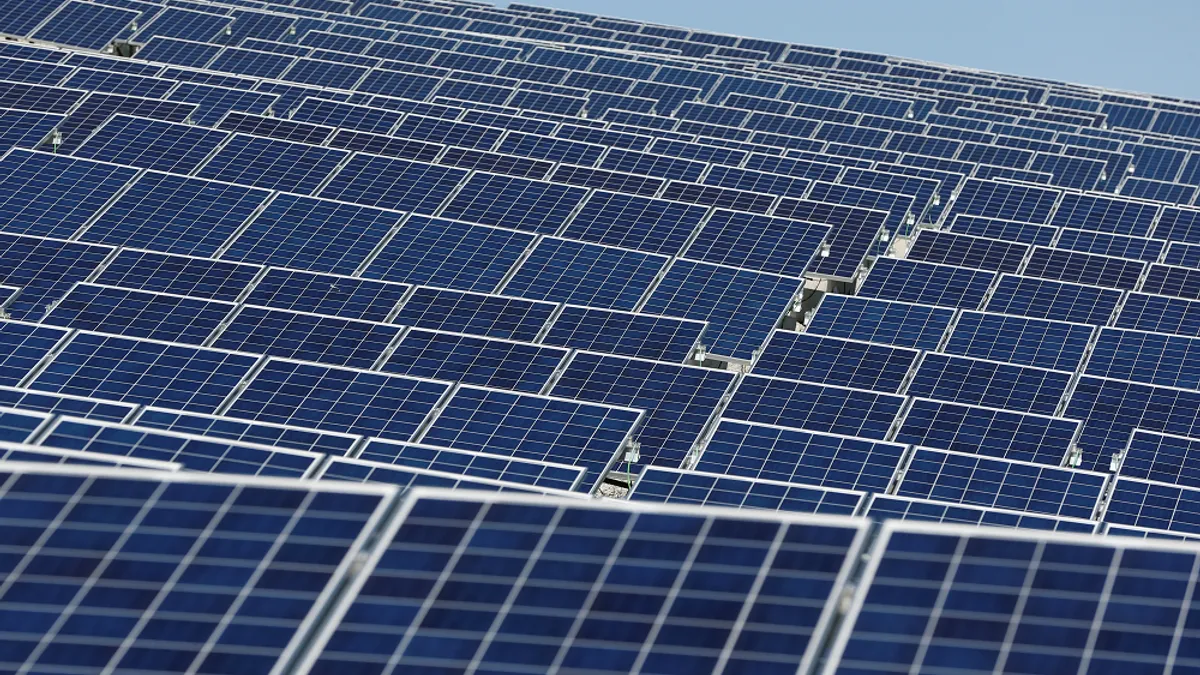Dive Brief:
- Arizona utility regulator Andy Tobin on Tuesday announced a proposal for utilities in his state to site 80% of their electricity from renewables and nuclear by 2050 and deploy 3,000 MW of energy storage by 2030, along with reforms to boost energy efficiency, electric vehicles and biomass.
- The proposed "Clean Peak Standard" in Tobin's Energy Modernization Plan would require utilities to deliver an increasing portion of their renewable energy during peak electricity demand hours, incentivizing storage deployment. A similar proposal was floated in 2016 by the state consumer advocate.
- The proposal would also alter utility planning processes to include more scenarios and integrate the goals of the Modernization Plan.
Dive Insight:
Arizona's power sector is at a crossroads. Its investor-owned utilities have already met the state's 15% renewable energy mandate and utility efficiency goals will sunset by 2020.
At the same time, the state's utilities are doubling down on natural gas. The integrated resource plan for Arizona Public Service, released last April, would see the company add 5.3 GW of gas generation by 2030, more than doubling its current capacity. Tucson Electric Power's plan includes nearly 360 MW of new gas by 2032, a 30% increase in gas capacity.
The Arizona Energy Modernization Plan aims to tackle all those issues at once, dramatically increasing the state's clean energy mandate, reforming it to reflect customer demand patterns, and setting up new programs for efficiency, biomass and electric vehicles.
Under the renewables mandate, labeled the "Clean Peak Standard," regulators would establish how much electricity from renewables each utility delivers during peak demand hours today. Utilities would then have to "incrementally increase that baseline figure 1.5% per year on average until 2030," according to Tobin's plan.
The Clean Peak element of the Modernization Plan was first proposed by the Residential Utility Consumer Office (RUCO), the state consumer advocate, in 2016. Commissioner Tobin quickly endorsed the idea and pushed forward with public hearings and workshops on the proposal before integrating it into his larger plan.
If approved, the plan would make Arizona "the first state to attempt to modernize its renewable portfolio standard to reflect the recent advances in energy technologies," Lon Huber, a consultant who worked to craft the original RUCO proposal, said. "What this plan is saying is we aren’t going to build our future on natural gas — the backbone of the system over the next 40 to 60 years will not be gas.”
In addition, utilities would also face a target to deploy 3,000 MW of energy storage by 2030, with yearly progress checks as a part of the clean energy mandate.
"In order to reduce curtailment and unlock the peak shaving and grid support capabilities of existing renewable resources," Tobin wrote, "priority should be given to exploring retrofits of existing renewable energy resources that currently lack energy storage solutions."
Tobin's proposal would also direct utility regulators to devise a new efficiency program within 120 days to meet the goals of the clean energy standard. Details would be left up to the rulemaking proceeding, but energy efficiency gains would count toward the utility's renewable energy goals.
Additionally, the plan would direct utilities to propose EV charging programs for new and existing homes, commercial and industrial customers and on major freeways. It would also direct the procurement of 60 MW of biomass energy to aid in Arizona's efforts to thin forest underbrush, which worsens wildfires.
Finally, the Modernization Plan would direct regulators to begin reforming the utility IRP process in Arizona, pushing utilities to add more scenarios and targeted analysis for clean energy into their generation plans.
"The lack of clear energy policy in the State has resulted in each utility using their own strategies as the guiding principles in developing their IRP," Tobin wrote. "As such, the rules and regulations governing the IRP process shall be amended for the purpose of supporting and promoting the policies adopted herein."
The prospects for Tobin's proposal are unclear. In an emailed statement, APS officials said Tobin had "set forth a bold, challenging vision for Arizona’s energy future," but did not express outright support.
"We share his goal of continuing Arizona’s leadership in clean energy, battery storage, electric vehicles and other elements of a smart energy infrastructure," an APS spokesperson emailed. "Commissioner Tobin’s plan also recognizes the critical role emission-free nuclear energy plays in any serious plan for clean Arizona energy."
TEP declined to comment on the proposal, but officials at the utility have been critical about the Clean Peak concept in the past, with a former TEP executive saying last year it "solves a problem we don't have."
In a release, Tobin praised Commissioner Boyd Dunn for work they've done together on forests and biomass, but Dunn's office did not respond to a request for comment, nor did Commissioner Justin Olson.
Tobin's proposal indicates he will ask the full ACC to consider the proposal at its Feb. 6-7 meeting. ACC Chairman Tom Forese sets the agenda for the meeting, but his office also declined to comment.
Commissioner Robert Burns said by email he is open to Tobin's proposal, but will reserve judgment until he hears from stakeholders. Burns said he is specifically interested in how the Energy Modernization Plan will fit in with Tobin's recent efforts to prolong the life of the Navajo Generating Station, a 2,250 MW coal plant slated to retire in the early 2020s.
Tobin appealed to the Trump administration last May for financial support for the plant, but it is not mentioned in the Modernization Plan.
A previous version of this article incorrectly said the proposal would require 80% of clean energy by 2030. The article has also been updated to include a comment from APS.













